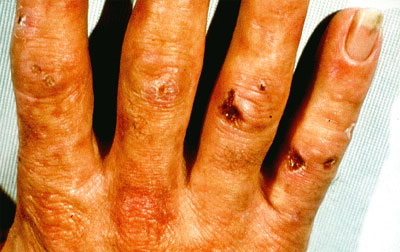|
|
|
Porphyria cutanea tarda
Porphyria cutanea tarda (PCT) is a group of disorders characterized by increased porphyrins in the plasma, urine and feces.
Usually acquired, it can also be inherited as an autosomal dominant trait.
When acquired, it is usually secondary to liver damage, most typically from alcohol abuse. Alcohol and estrogens may also precipitate autosomal dominant PCT.
Patients with PCT typically have increased facial hair and blisters on the dorsum of the hands that heal with scarring and milia. Sclerotic plaques may also develop. There is marked skin fragility in sun-exposed skin areas. Increased hair may be noted on the sides of the face and periorificial violaceous discolorations.
Lesions similar to PCT can be seen in some dialysis patients, the so-called pseudo-porphyria.
Patients with PCT show a pink fluorescence of the urine under Wood's light. Uroporphyrin is markedly elevated in the urine.
Treatment:
- If secondary to alcohol or estrogens, the offending etiologic agent should be discontinued.
- Sunscreens are often not particularly helpful as patients can react to visible light. Sun avoidance is important.
- Venisection, the removal of 500 ml of blood q 2 weeks, gradually results in remission.
- Oral cloroquine, starting at very low doses to avoid an acute exacerbation of symptoms, can also be highly effective.
- For patients with pseudoporphyria secondary to dialysis, erythropoietin in combination with venisection may be helpful.

Back to Dermatology Glossary - P Index |
Back to Dermatology Glossary Index
|